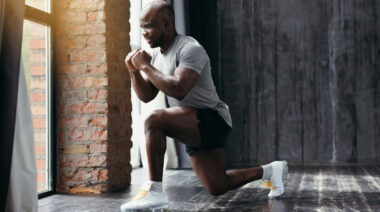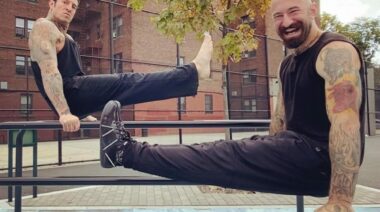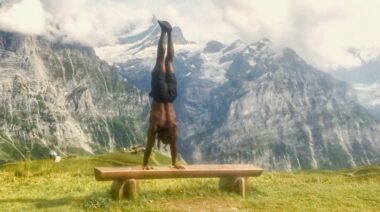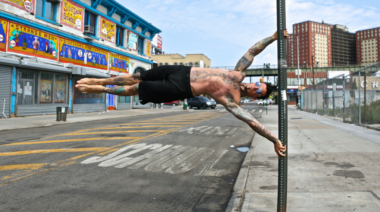Human flagpoles or press-to-handstands are some of the coolest displays of physical strength. Many people who want to learn these movements either have no idea where to begin or have been stuck on progressions for months.
It is easy to get caught up in trendy accessory work or fancy exercises and tools, although time and again we are reminded that Mr. Miyagi was right: the most basic ways of training are almost always the most effective. Want to bicycle kick a goal in a soccer game? Practice the bicycle kick every practice. Want to deadlift 500 lbs.? You’re going to have to deadlift consistently. The same applies with calisthenic or bodyweight skills.
In this article I am going to outline a simple progression to help you master any calisthenic movement using a technique that is not so secret: motor patterns.
You’ll never be able to do a human flagpole unless you practice the human flagpole.
Drill the Pattern
Creating a motor pattern is ingraining a movement into your central nervous system by doing it over and over again. The best way to do muscle ups, planches, and handstands is by doing them over and over again until they are permanently embedded in your central nervous system. The key to this technique is to always practice the full movement or position. I consistently see more advanced bodyweight movements being broken down, with athletes isolating certain parts of the movement. This neglects the motor pattern and is not the best way to condition the muscles for the movement. Now I know what you’re thinking, “but I can’t even do one muscle up, so how am I going to get better at them?” The answer is by performing these exact movements, but with various levels of assistance.
Instead of breaking down the movements into steps, perform the full motion of the exercise in this order of assistance: a plyometric box, assistance bands, and a partner. The plyometric box will support almost all of your weight in the beginning (the only move that will differ is the handstand where a wall will be used). A plyometric box can also be used to shorten the lever arm if needed. For example, putting the box under your thighs in the planche or under the hips in the human flag instead of at the end of the lever, which would be at the end of the feet. Over time put less of your weight on the box or wall, and use more of your strength to perform the exercise.
Once the movement with the plyometric box becomes comfortable, use various levels of assistance bands before moving on to working with a partner. Your partner can critique form and give you a little momentum boost or a tiny bit of extra support. For example, in the human flag your partner should be all the way at the end of your feet, just barely supporting them with a couple of fingers. Your partner can also help increase your muscular endurance. Start holding the human flag by yourself, then have your partner give you two fingers or support after five seconds, four fingers of support after ten seconds, and support a good portion of the load after fifteen seconds. For handstands, use a partner to form two columns on either side of your feet with their hands. When your feet begin drifting forward or backward too much, your partner will give your feet a small push back to the center.
Mastering the Muscle Up
This technique is simple and effective. When I first started getting into advanced calisthenics I could not perform a single muscle up. I could do nineteen strict dead hang chest-to-bar pull ups, but I couldn’t get past the transition of the muscle up. I had the strength and conditioning, but the movement felt foreign. I tried tons of different progressions, breaking down the movement, isolating certain parts, but still, nothing. Then one day it clicked, why not just do the full movement? Once I started using assistance progressions to establish the motor pattern of the movement, I finally became comfortable with the full movement and the muscle up came easy. I did my first muscle up in less than two training sessions. The next week I could do three repetitions without any assistance, the week after that five, and so on.
Since that day I have used assistance progressions to motor pattern almost every advanced calisthenic movement. I have seen clients who were stuck on certain movements for months, have a breakthrough in just one or two sessions using this simple training technique.
Here is the full list of motor pattern assistance progressions for the muscle up:
- Start out standing with two feet on a plyometric box in the height of the dip position.
- Next, squat down while performing the muscle up but keep all of the weight on the box, rather than using your upper body strength. Do this over and over. This is the best way to get used to the false grip, the transition, and the overall feel of the movement.
- Over time, put less of your weight on your feet and use more of your upper body strength to perform the movement. Once you can perform five reps using two feet, use only one foot to hold your bodyweight. Then use only the tiptoes on one foot.
- Next, use an assistance band under your knees. Start with a band that gives you 50lbs of assistance, then use a band with 30lbs of assistance, and a band with 15lb of assistance.
- Finally, have a friend push up the bottom of your feet for a little momentum.
Work on the on the full movement every single time to master the motor pattern, then make the assistance less and less as you become stronger in the movement.
Master the Basics
Training new and advanced movements with this technique will make progressions and programming seamless. There is no need for accessory work or complicated isolations. You will progress by building muscular endurance in each assistance. For static hold movements such as the planche, human flag, or levers, lighten the assistance when you can perform a static hold for 30 seconds at the current progression. For repetition movements such as the muscle up, handstand push up, or one arm pull up, build up to 5 repetitions at each assistance level before progressing. If you can’t perform the movement with full assistance, then you most likely have a mobility impairment that would need to be addressed before training.
Always perform the full movement to pound that motor pattern into your central nervous system. Get out there, be creative, find new environments, have fun, and soon you will be swooning people with your calisthenic skills.
Protect your body from the aches and pains of bodyweight training:






